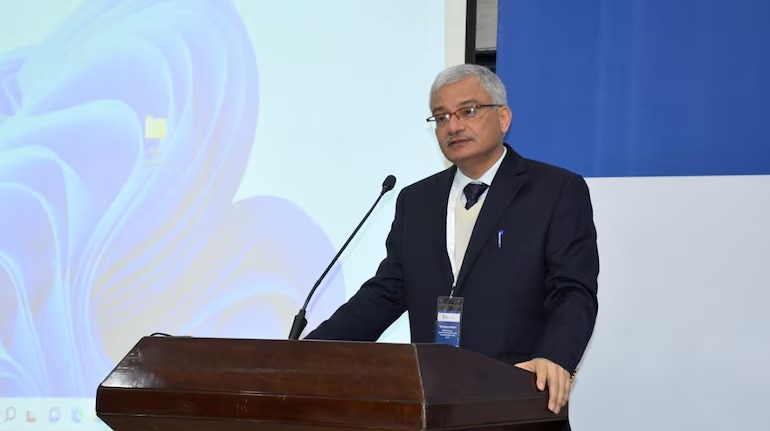
Govt to set up credit guarantee fund for small businesses in next 100 days : DFS Secretary
NEW DELHI : The union government plans to set up a credit guarantee fund for micro, small and medium enterprises (MSMEs) in the next 100 days, Mr. Vivek Joshi, Secretary at the Department of Financial Services, told in an interview. The fund will help banks provide bridge loans to small businesses and prevent their accounts from turning into non-performing assets (NPAs), he said.
“This fund will ensure a guarantee for banks to provide short-term loans to MSMEs categorised under SMA (special mention accounts) so that they can turn around their operations through such bridge loans by banks on the back of government guarantees,” Joshi said. “Currently, MSMEs under the SMA classification aren’t eligible for bridge loans,” he added. According to Joshi, banks’ exposure to MSMEs is currently about ₹28 trillion, with 4-5% of this being NPAs.
SMAs are accounts that show early signs of becoming NPAs, and are of three types – SMA-0, where the payment is overdue by 1 to 30 days, SMA-1 (31 to 60 days) and SMA-2 (61 to 90 days).
While presenting the Union Budget 2024-25 last week, Finance Minister Shri Nirmala Sitharaman announced a new mechanism to allow bank credit to flow to MSMEs during periods of stress. “While being in the SMA stage for reasons beyond their control, MSMEs need credit to continue their business and to avoid getting into the NPA stage. Credit availability will be supported through a guarantee from a government-promoted fund,” Sitharaman said.
Eye on public-sector insurers
Joshi said the government would keep a close eye on the financial performance of public-sector insurance companies — National Insurance Co Ltd, Oriental Insurance Co Ltd and United India Insurance Co – for the next 12 months before deciding whether to infuse more funds.
“Their solvency margins are not very encouraging. However, over the past year, their performance has looked better,” Joshi said. “They have come out of the red and are looking up. We will watch them closely for another year, see if they will start making profits, and then take a call,” he added.
A capital infusion would help improve the financial health of the three firms, including their solvency ratio – a measure of the financial buffer needed to settle all claims in extreme situations. The solvency ratio of all three public sector insurers is well below 1, lower than the 1.5 figure mandated by the insurance regulator to minimise risk.
Of the state-owned insurers, only New India Assurance is in a financially strong position. Its solvency ratio in FY24 was a healthy 1.81, and it remains the leader in India’s general insurance industry. Its profit after tax rose 7% to ₹1,129 crore in FY24.
The other three have fared poorly. National Insurance Co reported a net profit of ₹31 crore in the March quarter but a loss of ₹187 crore in FY24 as a whole. The company had reported a ₹3,865.40 crore loss in FY23. Its solvency ratio at the end of FY24 stood at -0.45.
Oriental Insurance Co’s net profit stood at ₹19 crore for FY24, up from a huge loss of ₹4,968 crore in FY23. Its solvency ratio stood at -1.06 at the end of FY24. United India Insurance Co reported a loss of ₹804 crore in FY24, and a ₹2,829 crore loss in FY23. The company’s solvency ratio stood at -0.59 in FY24.
Concerns about banks’ credit-to-deposit ratio
Expressing concern at the falling credit-to-deposit ratio of banks, Joshi said public-sector banks have been asked to chalk out a strategy to raise their deposit base and prevent a further drop in CASA (current account, savings account) from 41% of their total deposit base at present. CASA are non-term deposit accounts that pay a lower interest rate than term deposits and are a cheaper source of income for financial institutions.
“While at 41% CASA, the situation is still comfortable, but this fall should be arrested here,” Joshi said. “Banks have been asked to prepare robust long-term strategies to raise deposits through initiatives such as reducing their cost of doing business, better customer support and customer contact programmes, and better product design,” he added. The CASA of public sector banks peaked at 45% in 2022 and has been falling ever since. It hit 40.5% in 2024.
The drop in low-cost deposits and a rise in credit flows from the banking sector has raised eyebrows at the RBI, which has urged banks to find ways to bridge the gap between credit and deposit growth.
According to India Ratings, deposit growth for the banking system is expected to moderate to 12-13% in FY25 from 13.8% in FY24, further intensifying the competition for deposit accretion, especially CASA deposits.
